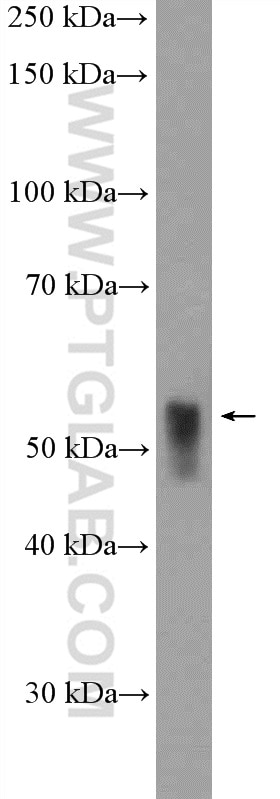TXNRD2 Polyklonaler Antikörper
TXNRD2 Polyklonal Antikörper für IHC, WB,ELISA
Wirt / Isotyp
Kaninchen / IgG
Getestete Reaktivität
human, Maus, Ratte und mehr (1)
Anwendung
WB, IHC, IF, ELISA
Konjugation
Unkonjugiert
Kat-Nr. : 16360-1-AP
Synonyme
Galerie der Validierungsdaten
Geprüfte Anwendungen
| Erfolgreiche Detektion in WB | HepG2-Zellen, HeLa-Zellen, MCF-7-Zellen, Rattenlebergewebe |
| Erfolgreiche Detektion in IHC | humanes Lebergewebe Hinweis: Antigendemaskierung mit TE-Puffer pH 9,0 empfohlen. (*) Wahlweise kann die Antigendemaskierung auch mit Citratpuffer pH 6,0 erfolgen. |
Empfohlene Verdünnung
| Anwendung | Verdünnung |
|---|---|
| Western Blot (WB) | WB : 1:1000-1:6000 |
| Immunhistochemie (IHC) | IHC : 1:50-1:500 |
| It is recommended that this reagent should be titrated in each testing system to obtain optimal results. | |
| Sample-dependent, check data in validation data gallery | |
Veröffentlichte Anwendungen
| WB | See 11 publications below |
| IHC | See 1 publications below |
| IF | See 1 publications below |
Produktinformation
16360-1-AP bindet in WB, IHC, IF, ELISA TXNRD2 und zeigt Reaktivität mit human, Maus, Ratten
| Getestete Reaktivität | human, Maus, Ratte |
| In Publikationen genannte Reaktivität | human, Hausschwein, Maus, Ratte |
| Wirt / Isotyp | Kaninchen / IgG |
| Klonalität | Polyklonal |
| Typ | Antikörper |
| Immunogen | TXNRD2 fusion protein Ag8367 |
| Vollständiger Name | thioredoxin reductase 2 |
| Berechnetes Molekulargewicht | 524 aa, 56 kDa |
| Beobachtetes Molekulargewicht | 54 kDa |
| GenBank-Zugangsnummer | BC007489 |
| Gene symbol | TXNRD2 |
| Gene ID (NCBI) | 10587 |
| Konjugation | Unkonjugiert |
| Form | Liquid |
| Reinigungsmethode | Antigen-Affinitätsreinigung |
| Lagerungspuffer | PBS mit 0.02% Natriumazid und 50% Glycerin pH 7.3. |
| Lagerungsbedingungen | Bei -20°C lagern. Nach dem Versand ein Jahr lang stabil Aliquotieren ist bei -20oC Lagerung nicht notwendig. 20ul Größen enthalten 0,1% BSA. |
Hintergrundinformationen
Human mitochondrial thioredoxin reductase (TXNRD2) is a selenocysteine-containing enzyme essential for mitochondrial oxygen radical scavenging. Three mammalian thioredoxin reductases exist; a cytosolic (TXNRD1), a mitochondrial (TXNRD2), and a testis-specific thioredoxin reductase (TXNRD3). (PMID: 21247928, PMID: 26199228)
Protokolle
| Produktspezifische Protokolle | |
|---|---|
| WB protocol for TXNRD2 antibody 16360-1-AP | Protokoll herunterladen |
| IHC protocol for TXNRD2 antibody 16360-1-AP | Protokoll herunterladen |
| Standard-Protokolle | |
|---|---|
| Klicken Sie hier, um unsere Standardprotokolle anzuzeigen |
Publikationen
| Species | Application | Title |
|---|---|---|
Nat Chem Biol Ribosome stalling during selenoprotein translation exposes a ferroptosis vulnerability. | ||
Oxid Med Cell Longev Paeoniflorin Upregulates Mitochondrial Thioredoxin of Schwann Cells to Improve Diabetic Peripheral Neuropathy Indicated by 4D Label-Free Quantitative Proteomics. | ||
Antioxidants (Basel) Selenium Status in Diet Affects Nephrotoxicity Induced by Cisplatin in Mice. | ||
J Biol Chem Redox regulation by TXNRD3 during epididymal maturation underlies capacitation-associated mitochondrial activity and sperm motility in mice. | ||
Sci Rep Selenocysteine insertion sequence binding protein 2 (Sbp2) in the sex-specific regulation of selenoprotein gene expression in mouse pancreatic islets. | ||
Photochem Photobiol Sci Tremella fuciformis polysaccharides alleviates UV-provoked skin cell damage via regulation of thioredoxin interacting protein and thioredoxin reductase 2 |






